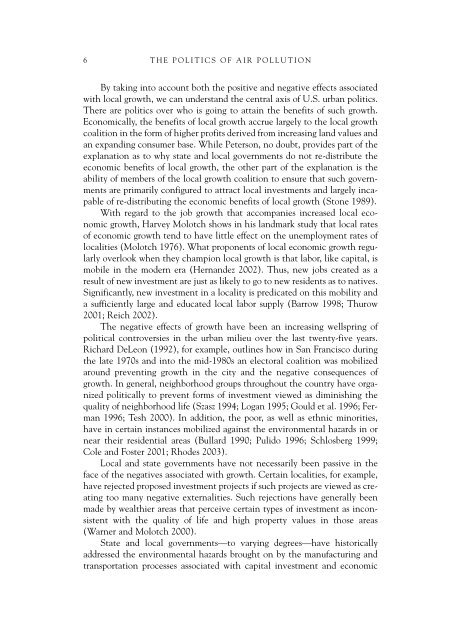GEORGE A. GONZALEZ - fieldi
GEORGE A. GONZALEZ - fieldi
GEORGE A. GONZALEZ - fieldi
Create successful ePaper yourself
Turn your PDF publications into a flip-book with our unique Google optimized e-Paper software.
6THE POLITICS OF AIR POLLUTIONBy taking into account both the positive and negative effects associatedwith local growth, we can understand the central axis of U.S. urban politics.There are politics over who is going to attain the benefits of such growth.Economically, the benefits of local growth accrue largely to the local growthcoalition in the form of higher profits derived from increasing land values andan expanding consumer base. While Peterson, no doubt, provides part of theexplanation as to why state and local governments do not re-distribute theeconomic benefits of local growth, the other part of the explanation is theability of members of the local growth coalition to ensure that such governmentsare primarily configured to attract local investments and largely incapableof re-distributing the economic benefits of local growth (Stone 1989).With regard to the job growth that accompanies increased local economicgrowth, Harvey Molotch shows in his landmark study that local ratesof economic growth tend to have little effect on the unemployment rates oflocalities (Molotch 1976). What proponents of local economic growth regularlyoverlook when they champion local growth is that labor, like capital, ismobile in the modern era (Hernandez 2002). Thus, new jobs created as aresult of new investment are just as likely to go to new residents as to natives.Significantly, new investment in a locality is predicated on this mobility anda sufficiently large and educated local labor supply (Barrow 1998; Thurow2001; Reich 2002).The negative effects of growth have been an increasing wellspring ofpolitical controversies in the urban milieu over the last twenty-five years.Richard DeLeon (1992), for example, outlines how in San Francisco duringthe late 1970s and into the mid-1980s an electoral coalition was mobilizedaround preventing growth in the city and the negative consequences ofgrowth. In general, neighborhood groups throughout the country have organizedpolitically to prevent forms of investment viewed as diminishing thequality of neighborhood life (Szasz 1994; Logan 1995; Gould et al. 1996; Ferman1996; Tesh 2000). In addition, the poor, as well as ethnic minorities,have in certain instances mobilized against the environmental hazards in ornear their residential areas (Bullard 1990; Pulido 1996; Schlosberg 1999;Cole and Foster 2001; Rhodes 2003).Local and state governments have not necessarily been passive in theface of the negatives associated with growth. Certain localities, for example,have rejected proposed investment projects if such projects are viewed as creatingtoo many negative externalities. Such rejections have generally beenmade by wealthier areas that perceive certain types of investment as inconsistentwith the quality of life and high property values in those areas(Warner and Molotch 2000).State and local governments—to varying degrees—have historicallyaddressed the environmental hazards brought on by the manufacturing andtransportation processes associated with capital investment and economic









